Physical Address
304 North Cardinal St.
Dorchester Center, MA 02124
The prevalence of diabetes and obesity has increased significantly, which has led to complications such as stroke, peripheral vascular complications, and chronic nonhealing wounds. , In most medical communities, surgeons are considered the local wound care experts and are expected to manage cases that do not respond to conservative treatments recommended by primary care clinicians. This chapter focuses on the diagnosis and management of chronic wounds of the extremities that are often sent to vascular surgeons for definitive management.
The most common etiologic factors in nonhealing limb ulcers are chronic venous insufficiency, arterial occlusive disease, and diabetic neuropathy. Although venous insufficiency is prevalent, patients with arterial insufficiency and diabetic neuropathy are at the highest risk of limb loss. Accurate identification and treatment of these underlying disorders is the most important determinant of ulcer healing.
In many communities, specialized wound clinics have been developed, promising major benefits in wound healing, limb salvage, and quality of life. , These centers, in optimal situations, are able to effectively coordinate the efforts of diverse specialists to improve the treatment of difficult patients with chronic wounds. It is clear that a vascular specialist is a critical component of the team that can provide the comprehensive management of arterial and venous insufficiency required by a high percentage of patients treated in wound centers. Similarly, a vascular surgeon participating in a multispecialty wound center can coordinate with specialists, including endocrinologists, plastic or orthopedic surgeons, podiatrists, orthotists, and physical therapists, to maximize positive outcomes for their patients.
Healing of acute wounds normally proceeds through well-defined phases of hemostasis, inflammation, proliferation, and remodeling. Although these phases are typically described separately, the process is actually a gradual progression guided and regulated by the complex interaction of platelets, neutrophils, macrophages, and other cells that respond to and produce growth factors, cytokines, proteases, and inhibitors. Although the effects of many of these proteins have been described, the deficiencies that lead to the failure of timely healing are not well described. It is clear that all of the common causes of nonhealing wounds, including venous hypertension, arterial insufficiency, chronic pressure, and chronic inflammation, inhibit this orderly healing process, usually creating stasis in the inflammatory stage, with little meaningful tissue proliferation demonstrated.
The inflammatory phase of wound healing is critical to the normal healing process. Mediated by mast cells, neutrophils, and macrophages, inflammation develops within 24 hours of acute wounding and continues for up to 2 weeks. The involved cells produce chemokines, cytokines, and growth factors that mediate the inflammatory process. Cytokines such as tumor necrosis factor-α (TNF-α), interferon-δ (IFN-δ), and the interleukins (ILs) are released by activated lymphocytes and macrophages into the tissue, resulting in further recruitment and activation of fibroblasts and epithelial cells in the wound. Neutrophils following chemoattractant signals migrate into the wound, releasing concentrated matrix metalloproteinases (MMPs). The MMPs are responsible for clearing damaged tissue from the wound area by breaking down collagen (MMP-1 and -8), gelatin (MMP-2 and -9), and elastin (elastase). The activity of MMPs is closely controlled by tissue inhibitors of MMPs (TIMPs), which are produced principally by macrophages.
In the proliferative phase, growth factors, including platelet-derived growth factor (PDGF), transforming growth factor-β (TGF-β), and vascular endothelial growth factor (VEGF), are secreted by multiple cell types but primarily by macrophages. They are responsible for the recruitment of fibroblasts to commence the proliferative phase and for the initiation of angiogenesis required to support tissue generation and epithelial growth. , Fibroblasts responding to signaling growth factors and cytokines migrate into the extracellular matrix, synthesizing collagen and proteoglycans and developing granulation tissue to fill the wound. Orderly capillary growth and networking must occur to support the developing granulation tissue; this requires a complex interplay of growth factors, including multiple isoforms of VEGF, TGF-β, and hypoxia-inducible factor-1 (HIF-1). , MMPs are also required for the normal progression of angiogenesis and must be secreted at the correct time by budding capillary loops to allow them to degrade the existing capillary basement membrane as they sprout to establish a new capillary channel.
Epithelialization occurs most rapidly on a well-granulated, confluent tissue bed, in response to signals from growth factors, such as epithelial growth factor and keratinocyte growth factor. Epithelial cells migrate into the wound from the periphery by secreting MMPs to degrade the nonviable tissue at the wound edge, allowing migration into the wound. Normally epithelial migration should continue until other epithelial cells are contacted.
Remodeling is a long-term process in which type III collagen is largely replaced by mature type I collagen. This process also requires the presence of MMPs to degrade the type III collagen in a controlled fashion mediated by TIMPs, facilitating its replacement with maturing type I collagen.
Chronic nonhealing wounds occur when the normal healing process is disrupted. This is most frequently the result of an underlying disorder that causes a prolonged, unchecked proinflammatory state. These disorders include venous hypertension, chronic pressure, bacterial colonization, inadequate tissue perfusion, and cellular senescence.
Recurrent or prolonged inflammatory stimuli result in chronic wounds that are characterized by persistent upregulation of proinflammatory cytokines and MMPs. Although this environment is necessary for a brief period for acute wound healing, persistence of this environment has detrimental effects. Wound fluid collected from chronic nonhealing ulcers has been reported to inhibit DNA synthesis and mitotic activity of normal skin fibroblasts and keratinocytes. In contrast, fluid collected from acute wounds stimulate these measures of cellular activity. Chronic wound fluid may contain high levels of MMP-2 and MMP-9 and abnormally low levels of TIMPs. In venous ulcers, MMP levels decrease after compression treatment. In a study of 56 patients with pressure ulcers, Ladwig et al. found that the ratio of MMP-9 to TIMP-1 was associated with wound healing outcomes: an elevated concentration of MMP-9 in relation to TIMP-1 was predictive of poor healing. Although this upregulation of protease levels might be expected to degrade endogenous growth factors, Drinkwater et al. reported that the level of VEGFs in venous ulcer tissue was not decreased and was persistently high compared with normal tissue, and was equivalent to levels in tissue from acute wounds. In a separate study, these researchers found that fluid from venous ulcers inhibited angiogenesis, postulating that this effect must be caused by the presence of inhibitors or a lack of available receptors rather than an absence of stimulatory growth factors. Patients with critical limb ischemia (CLI) also demonstrate deficits of growth factor function. Palmer-Kazen et al. found that distal limb tissue in patients with CLI had lower levels of VEGF compared with nonischemic proximal tissue in the same limb.
Upregulation of proinflammatory cytokines, including TNF-α, IL-1, and IL-6, has also been described in chronic venous wound fluid. These levels were found to improve when ulcers began to heal, with a decrease in size and improvement in granulation. Diabetic foot ulcers may also display proinflammatory upregulation and low expression of angiogenic factors.
Cellular senescence has been reported in fibroblasts collected from chronic nonhealing ulcers. Lal and colleagues found that fibroblasts from patients with increasing levels of venous disease by clinical class, etiologic, anatomic, and pathophysiologic (CEAP) criteria displayed a progressively diminishing response to agonist-induced proliferation. Fibroblasts from CEAP class 6 patients displayed severe inhibition of the proliferative response to TGF-β1. Mendez and colleagues reported a series of studies of cultured fibroblasts from venous ulcers, indicating that these typically display phenotypic characteristics of cellular senescence, including slow growth and altered morphology. Stimulation of senescent fibroblasts may be a key target of therapy for improving the healing potential of chronic leg ulcers.
The development of therapeutic targets based on the known mechanisms of poor healing has been difficult, given its overall complexity. Initial strategies at modulating protease expression have not yielded major improvements in healing. A dressing composed of a combination of collagen and regenerated cellulose (Promogran, Systagenix, North Yorkshire, United Kingdom) has been developed, based on its ability to bind MMPs in wound fluid in vitro . However, in a prospective randomized study of 276 patients with diabetic foot ulcers, treatment with this dressing for 12 weeks failed to result in a significantly higher incidence of complete healing (37%) compared with ulcers treated with saline-moistened gauze (28%).
General treatments for the reduction of inflammation such as doxycycline and nonsteroidal anti-inflammatory drugs have been studied in animal models and considered for clinical use. However, a literature review of pharmacological agents for venous leg ulcer healing did not find evidence to recommend routine use of these agents. Some researchers believe that the simple inhibition of upregulated proteases or cytokines is unlikely to yield significant gains in healing. As evidenced by the importance of MMPs in multiple aspects of the normal healing process, gross inhibition of their function impairs capillary development, epithelial migration, and collagen maturation. Beidler et al., in an analysis of cytokine levels and venous ulcer healing, found that untreated ulcers with higher levels of proinflammatory cytokines, including IL-1, IL-12p40, and IFN-δ, healed significantly better than those with lower levels of these cytokines before compression. It is clear that strategies to address the abnormal progression of healing in chronic ulcers must consider that inflammation is necessary at various points in the process and must be suppressed at other stages. Currently no diagnostic modalities are available to rapidly test the MMP or cytokine levels in wound fluid or tissue in a laboratory setting, but clinically relevant testing strategies are under development.
The successful treatment of patients with nonhealing leg ulcers requires that the underlying cause of ulceration be correctly diagnosed. Common differential diagnoses of leg ulceration are provided in Table 118.1 . It has been reported that multiple causes are involved in more than 20% of leg ulcers, so it is clear that each potential diagnosis must be considered in every patient. Based on the history and physical examination, the proper cause or causes of chronic ulcers can be defined in the majority of patients, but if doubt remains, confirmatory noninvasive testing should be performed.
| Etiology of Wound | Differential Diagnosis | Method of Investigation |
|---|---|---|
| Infectious conditions | Mycobacterial Fungal Bacterial Treponemal/spirochetal |
Wound biopsy with special stains and cultures, VDRL, PPD, CBC, ESR, C-reactive protein, chest X-ray, wound X-ray |
| Malignancy | Basal cell carcinoma Squamous cell carcinoma Kaposi sarcoma Lymphoma Mycosis fungoides |
Wound biopsy for pathologic evaluation |
| Macrovascular arterial insufficiency | Arteriosclerosis Posttraumatic Embolic Acute or chronic thrombosis |
Noninvasive vascular studies Bidirectional color Doppler, tcPO 2 Contrast arteriography Computed tomography arteriography Magnetic resonance arteriography |
| Vasculitis/vasculopathy (microvascular arterial insufficiency) | Diabetic microangiopathy Hypertensive microangiopathy Thromboangiitis obliterans Raynaud disorder |
tcPO 2 Laser Doppler Possible biopsy |
| Venous insufficiency (deep and superficial) | Deep venous thrombosis Extrinsic compression (tumors) Deep valve insufficiency Perforator valve insufficiency Superficial venous insufficiency |
Strain gauge plethysmography (maximum venous outflow) Venous photoplethysmography Bidirectional color Doppler Air plethysmography |
| Lymphatic obstruction/lymphedema | Venolymphatic disease (secondary to congestive heart failure, hepatic failure, renal failure, other overload states) Primary or secondary lymphatic insufficiency Lymphangiosarcoma |
Clinical diagnosis, history, physical examination, chest X-ray, liver function tests, chemistries, lymphangiography |
| Hematologic abnormalities | Anemia (sickle cell) Polycythemia Dysproteinemia |
CBC, iron studies (Fe, TIBC, folate, B 12 ) Sickle cell prep |
| Collagen vascular disorders | Systemic lupus erythematosus Scleroderma Polyarteritis nodosa Wegener granulomatosis |
FANA Rheumatoid arthritis prep Serum complement Rheumatologic workup |
| Excessive pressure | Diabetic neuropathy Alcoholic neuropathy Decubitus ulcer Postoperative deformity Bone spurs |
Monofilament (10 g) Vibratory sensation (>25 mV) X-rays |
The epidemiology and pathophysiology of venous leg ulcers are described in Chapter 156 (Chronic Venous Disorders: Post-Phlebitic Syndrome, Natural History, Pathophysiology, and Etiology). Risk factors related to the development of venous ulcers are the same as those for the development of venous disease in general. It is important to understand that venous disease in any combination of anatomic sites may result in limb ulceration, including superficial venous insufficiency alone. The anatomic sites of venous reflux defined by duplex ultrasound examination in a series of 138 patients with venous leg ulcers are listed in Table 118.2 .
| Venous System | Limbs (%) |
|---|---|
| Deep alone | 43.5 |
| Deep and superficial | 21.0 |
| Deep, perforator, and superficial | 6.5 |
| Superficial alone | 18.1 |
| Superficial and perforator | 10.9 |
The pathway between chronic venous hypertension and limb ulceration has been debated for years. In some patients, persistent venous hypertension with chronic limb edema leads to the gradual development of skin changes. Chronic upregulation of pro-inflammatory cytokines appears to mediate the development of tissue fibrosis and the clinical appearance of lipodermatosclerosis ( Fig. 118.1 ). This is believed to be a preulcerative condition that should stimulate treatment to correct the underlying venous pathology or eliminate edema to reduce the risk of future ulceration. Ulceration eventually occurs either spontaneously or due to minor limb trauma in the lower calf or ankle that then does not heal.
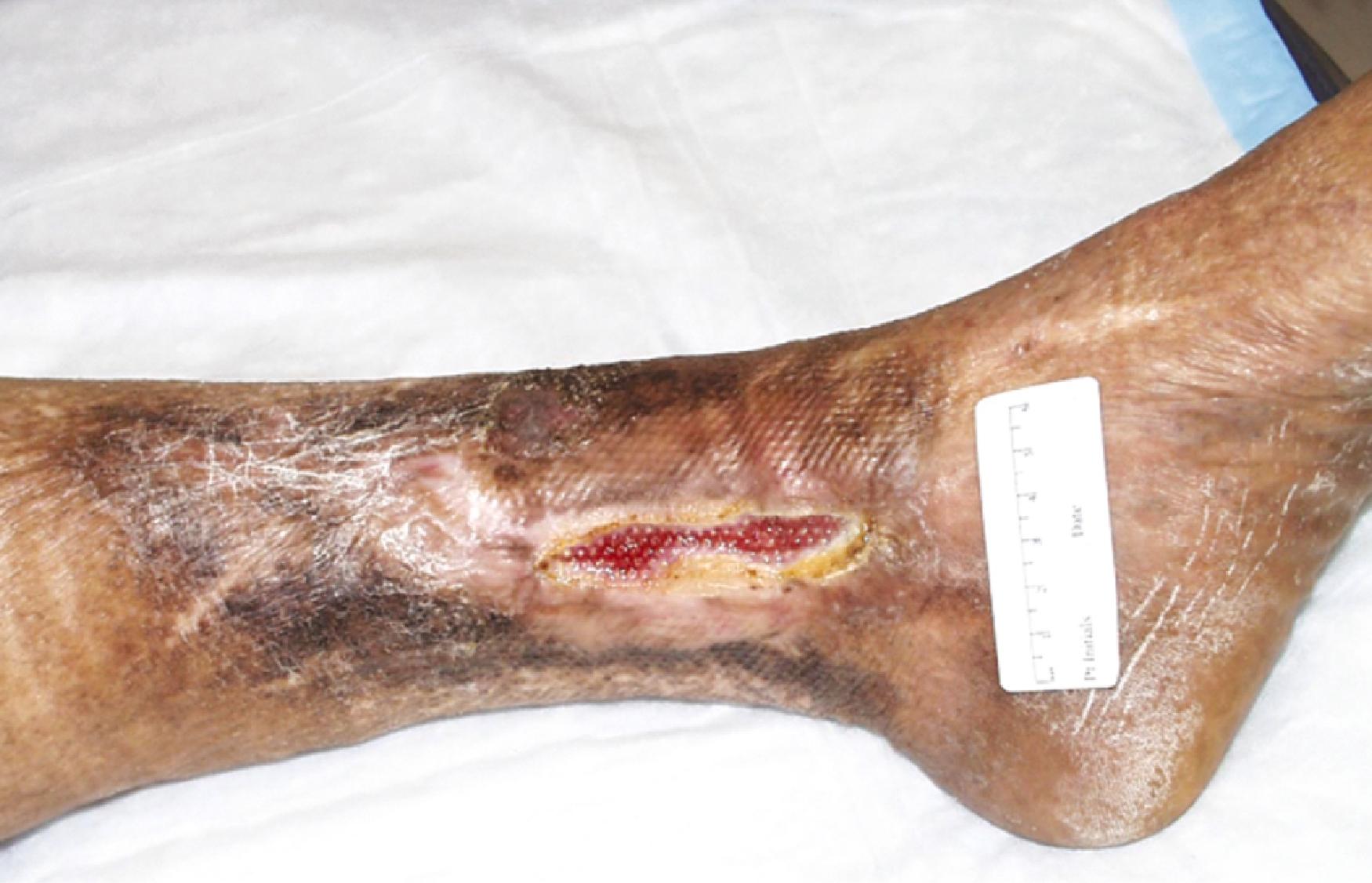
The epidemiology and pathophysiology of diabetic foot ulcers are reviewed in detail in Chapter 119 (Podiatric and Vascular Teams). For management purposes, it is critical to remember that the underlying causes of ulcers, such as polyneuropathy, vascular insufficiency, and infection, must be addressed before specific wound treatments can assist in healing. Inadequate pressure offloading is the most common cause of failure to heal, and no active wound therapy can overcome persistent pressure on a plantar ulcer. The assistance of an expert orthotist and consistent patient education to achieve compliance are far more important to the healing of diabetic foot ulcers than the specific dressing or agent selected.
The treatment of patients with chronic nonhealing leg ulcers associated with arterial insufficiency involves a critical assessment of the patient’s suitability for invasive procedures and the potential risk of limb loss based on ulcer characteristics. Data from several clinical trials studying CLI have identified a risk of major amputation in 25% to 40% of patients at 1 year if revascularization is not performed. , However, the hemodynamic criteria for CLI are broad and further evaluation of the specific level of perfusion to the wound bed is needed to predict which patients have a good chance of healing without revascularization. It appears clear that the severity of the wound itself is important, such that a superficial partial-thickness wound ( Fig. 118.2 ) may not require the same level of perfusion as a deep, complicated leg ulcer involving tendon or bone ( Fig. 118.3 ) to achieve healing. The WIfI classification system (see the section on Wound Classification Systems later) was designed to capture the severity of wound tissue damage, arterial insufficiency, and infection as an aid to prediction of healing potential.
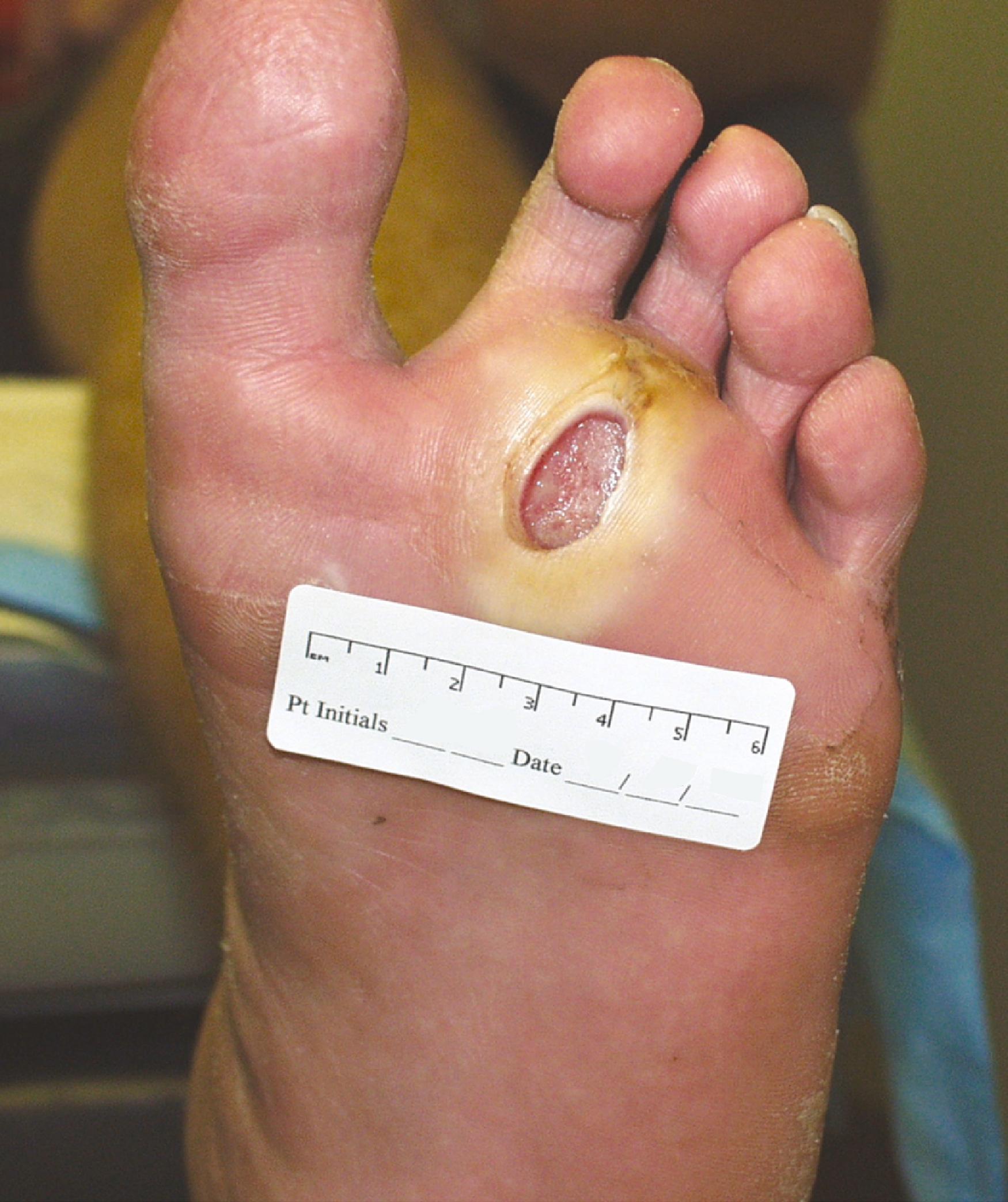
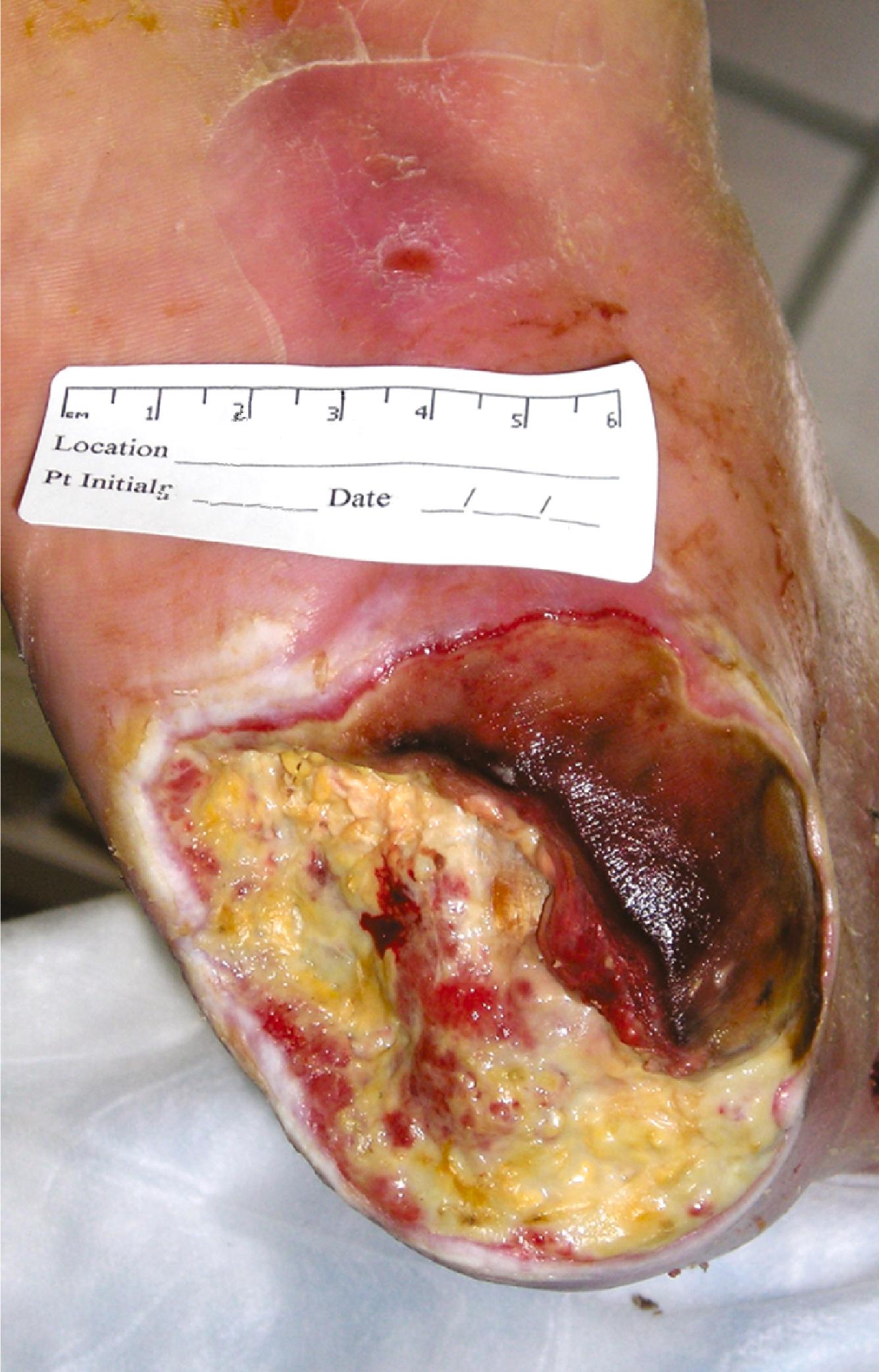
The natural history of chronic wounds with arterial insufficiency that do not receive revascularization was reported in a study of 169 limbs. At 1-year follow-up, 52% of limb ulcers were healed, and 23% required amputation ( Fig. 118.4 ). Risk factor analyses revealed that the ankle–brachial index (ABI) and wound grade were associated with amputation at 1 year. In another study of nonrevascularized patients with CLI and wounds, limbs were separated into groups based on the toe pressure in the affected limb. If the toe pressure was 20 to 50 mm Hg, 85% of patients were able to achieve limb salvage with wound management using standard multispecialty wound protocols, compared with only 60% in those with a toe pressure less than 20 mm Hg. Unfortunately, survival in these patients is poor, particularly in the patients with the lowest toe pressures less than 10 mm Hg, in whom only 8% of patients achieved amputation-free survival at 3 years. This is due to severe medical comorbidities affecting these patients, including a high prevalence of renal failure and cardiac dysfunction, which also lead to higher risks for efforts at revascularization. This information suggests that some patients with AI and wounds who are at high risk for a poor outcome with revascularization can be reasonably treated without revascularization, and many will experience limb salvage. Revascularization should be considered early in those who have rest pain, those with more severe wound grades, and those with pedal gangrene. Wounds treated initially with wound management without revascularization should be monitored closely for progress, and if this does not occur within 4 to 6 weeks, revascularization should be considered. Arterial insufficiency is a common complicating factor for limb ulcers associated primarily with other causes, including venous insufficiency, diabetes, and rheumatoid arthritis. It is important that the status of the arterial supply be determined in every patient at the initial evaluation.
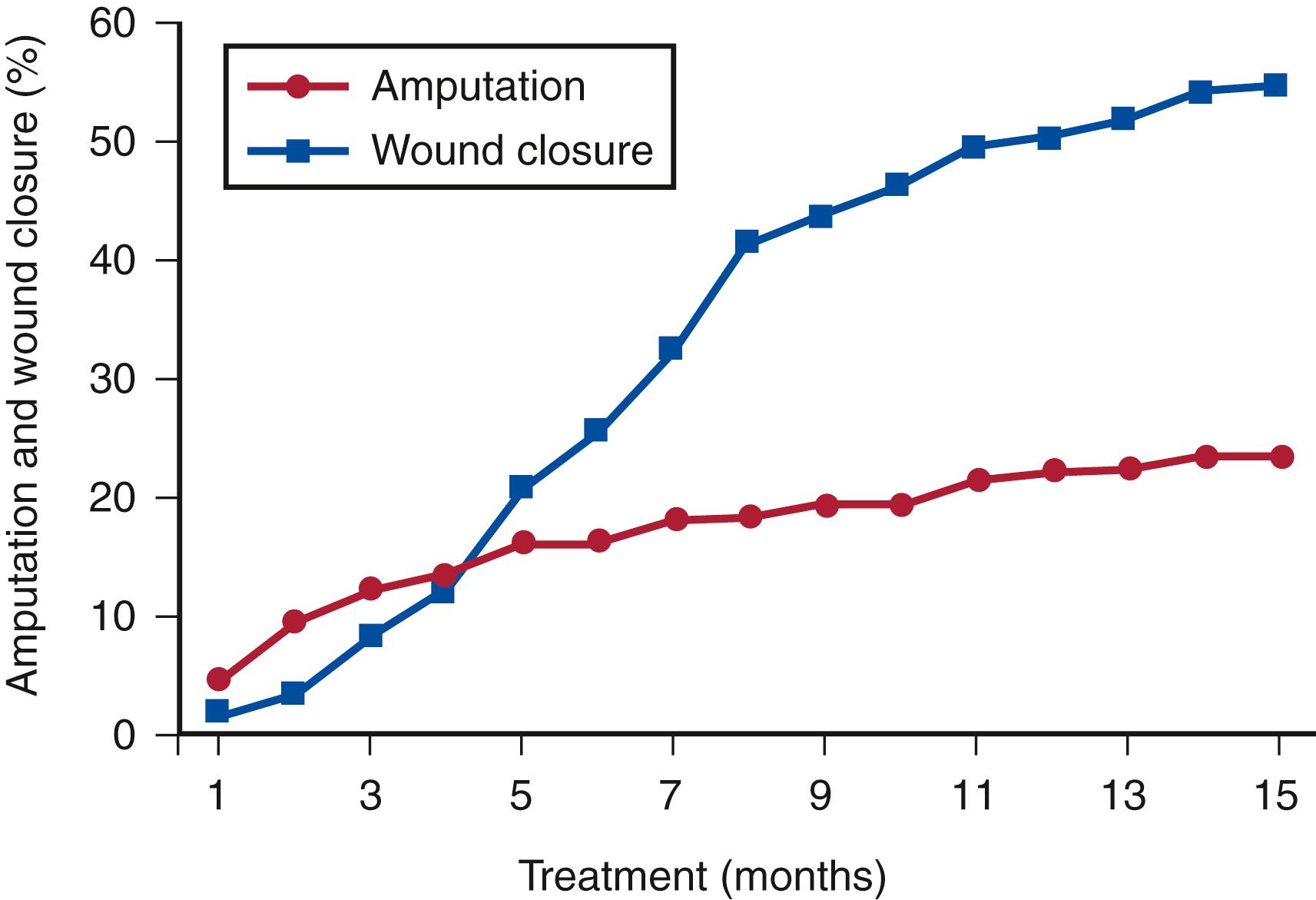
Although the preceding causes are important factors in more than 90% of nontraumatic limb ulcers, other causes, including vasculitis, sickle cell anemia, malignancy, and dermatologic disease, are routinely seen by vascular specialists. It is beyond the scope of this chapter to review these leg ulcers in detail. The key to diagnosing these atypical causes is ulcer biopsy. Many of these conditions may be confused with venous ulceration and may coexist in a patient with chronic venous insufficiency. The most important diagnosis to make is Marjolin ulcer, which may develop when squamous transformation occurs in a preexisting benign chronic wound ( Fig. 118.5 ). This neoplasm is often not detectable by observation, so the physician must maintain a high index of suspicion. Whenever a wound does not respond to a comprehensive treatment plan as expected or a wound that has been healing ceases to progress for no known reason, a biopsy should be performed to rule out malignancy. Further information on the diagnosis and management of atypical wounds is beyond the scope of this chapter.
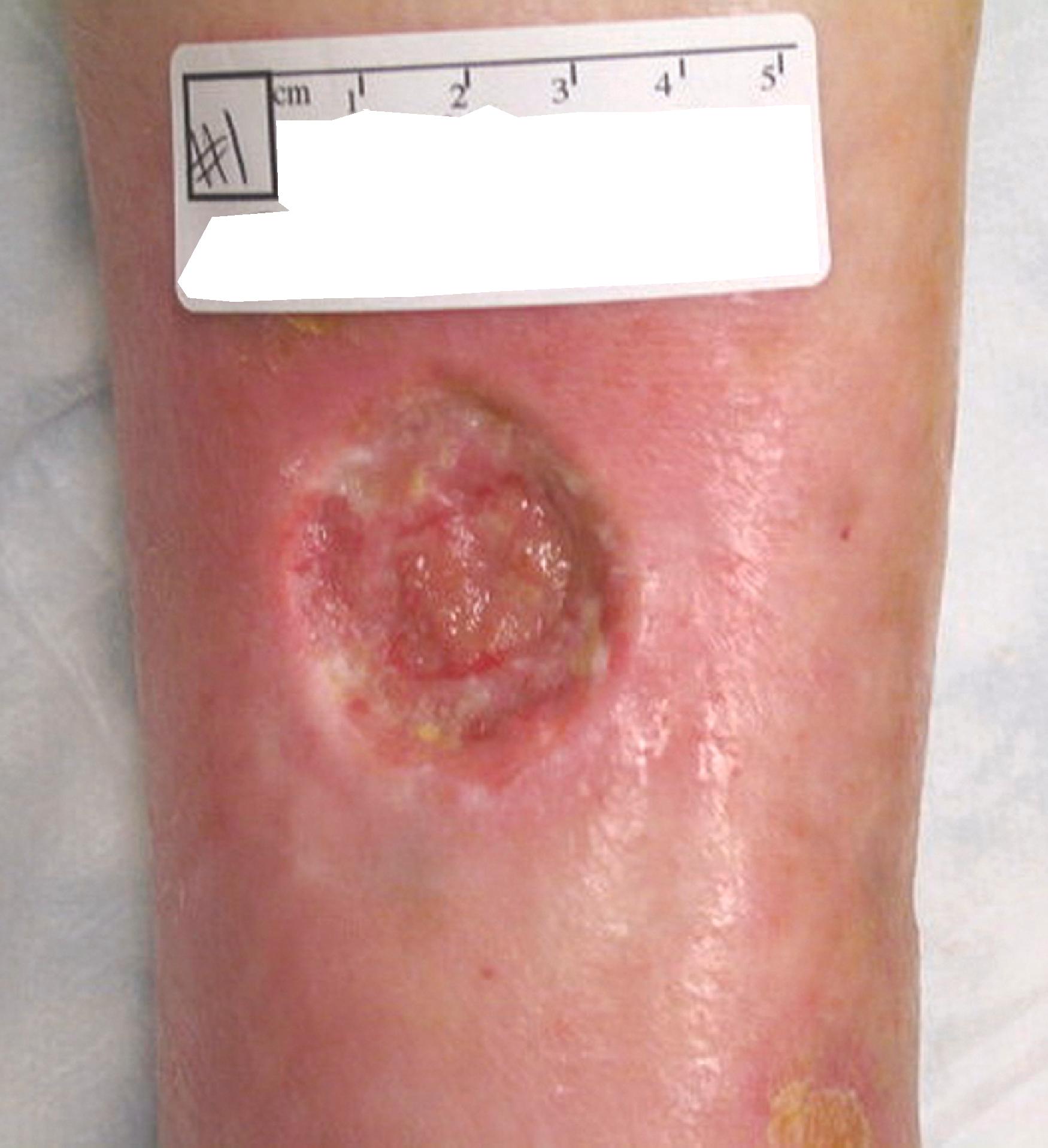
The primary cause of most wounds can be identified after the history and an attentive physical examination. Figure 118.6 contrasts common types of lower extremity ulcerations.
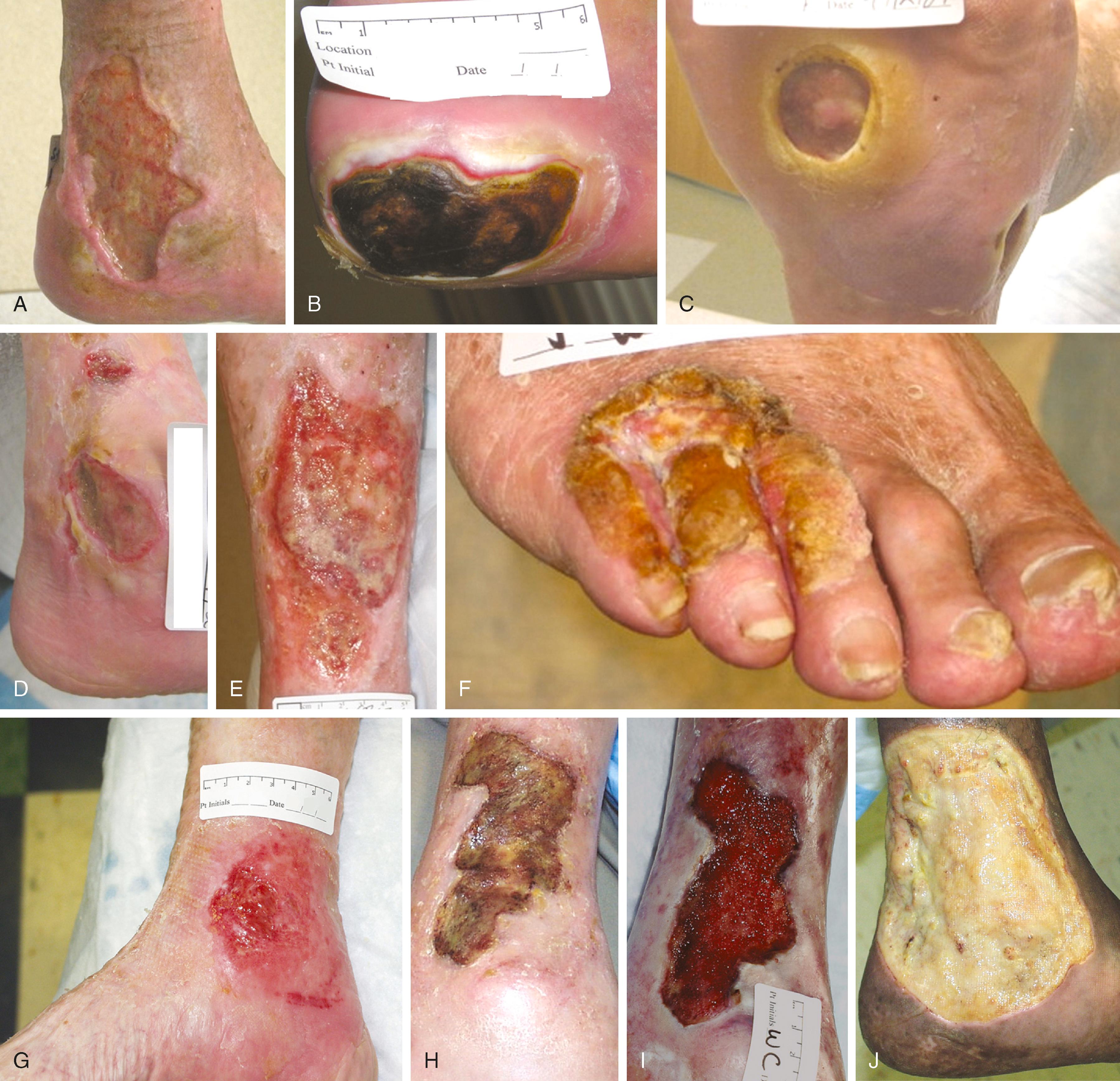
Key factors in describing wounds include depth, infection and ischemia. The earliest recognized system for classification of diabetic foot ulcers was the Meggitt–Wagner grading system. This included depth, infection and ischemia, but did not allow for adequate concomitant description of these factors. It therefore lost some of its descriptive and predictive potential. It was replaced by the University of Texas Classification System. It included depth, infection and ischemia for each grade and stage and was more predictive of outcome. UT, however, only included a “yes/no” for both infection and ischemia ( Table 118.3 ). ,
| Grade | Criterion | Amputation at 12 Months (%) |
|---|---|---|
| 0 | Preulcerative lesion | |
| 1 | Superficial ulcer | 12 |
| 2 | Ulcer extending deep to tendon, bone, or joint | 19 |
| 3 | Deep ulcer with abscess or osteomyelitis | 31 |
| 4 | Forefoot gangrene | 49 |
| 5 | Whole foot gangrene | 100 |
In an attempt to address the evolving interdisciplinary nature of limb preservation and to address some of the issues listed above, Mills and coworkers proposed a new classification of the threatened lower extremity that also includes the presence and extent of wound ischemia and infection. The WIfI classification (see Table 107.3) has been widely validated to correlate to the risk of amputation in several subsequent publications. Additional “add-ons” to the WIfI system have included ambulatory function to assist in decision-making. , ,
At each visit, it is important to measure the wound size to document progress and alter the treatment plan if necessary. Subtle changes in the wound itself, including the development of inflammation or bacterial colonization, may manifest only as the suppression of healing. Routine wound measurement allows the consideration of alternative treatment methods as soon as progress in wound healing ceases.
Numerous methods are available to document and follow wound size, including digital photography with computerized planimetry, direct planimetry, and simple measurement of dimensions. Software systems are also available to allow the determination of wound size from calibrated digital photography.
Become a Clinical Tree membership for Full access and enjoy Unlimited articles
If you are a member. Log in here